No pair of hiking boots lasts forever, and since high-quality boots are an expensive hiking essential, you’re probably wondering how long they’ll last for the money you spend. Many online articles on this topic suggest that robust hiking boots last from 600 to 700 miles (900-1200 km) and their lightweight counterparts from 400 to 500 miles (650-800 km). However, I find this inaccurate because the lifespan of hiking boots does not only depend on the mileage spent nor just on the materials out of which they’re made. You have to also take into consideration the terrain you’re using them on, how you store them and how you care for them (maintenance). Furthermore, materials degrade with time and it’s not uncommon that 5 years old boots, which were worn only a couple of times, are too damaged to be worn comfortably.
Therefore, I will not be estimating milage here but rather focus on explaining what makes some boots more durable than the others. I will also share the lifespan of my own hiking footwear for the last 15 years, give advice on when to replace your hiking footwear and how to increase its lifespan. As the last thing we’ll look into warranty policies of popular brands that produce hiking footwear.
Table of contents:
- Lifespan of hiking boots and shoes in my experience
- When to replace your hiking footwear?
- How to increase the lifespan of you hiking footwear?
- What warranty do hiking footwear companies offer
- Conclusion
Lifespan of hiking boots and shoes in my experience
Through time I learned that materials play a crucial role in the durability of hiking footwear. The most important are the materials of the uppers and midsoles respectively. The midsole is the layer of the sole that it’s responsible for cushioning and is made either of EVA (Ethylene-Vinyl Acetate) or PU (Polyurethane). Uppers, on the other hand, are made either of textile or leather. You can be almost certain that boots with PU midsoles will last longer than those with EVA midsoles, and that boots with leather uppers will have a longer lifespan than boots with textile uppers. Nevertheless, it’s important to note that highly durable materials like leather and PU also have minor disadvantages (like being heavier) but you can read more about this in my Guide to Hiking Footwear. Now, let’s have a look at how long my own hiking footwear has lasted.
I bought my first quality hiking shoes in 2008. They were from Salomon, a typical mid-range hiking shoe which had an upper made of suede leather with synthetic inserts for increased ventilation. The midsole was made of EVA foam. I wore these shoes weekly for fast hiking and they were holding up pretty well. But after a bit more than 3 years I noticed that they lost basically all cushioning. The EVA midsole simply gave up. The uppers were still undamaged, and my father kept using these shoes for cutting grass in the garden for the next 8 years. So, bit of a mismatch between the durability of the uppers versus the midsole.
The next pair of hiking shoes was from the German brand Lowa. The Lowa Innox shoes feature PU midsoles and synthetic uppers with Gore-Tex lining. I really liked these shoes because they offered incredible support and stability. However, I had to throw them out before they were 3 years old. I wore them both for hiking and everyday use. First, the Gore-Tex lining got torn and the shoes started leaking. Soon after that I started spotting tears in the textile uppers and the shoes quickly became too damaged to be worn. However, I must mention that when I threw them out the PU midsoles were still providing the same support as when I bought them. Again, bit of a mismatch between the durability of the midsole versus the uppers.
For a bit less than a year now, I’ve been wearing the Danner Trail 2650 GTX shoes for hiking and everyday use. Already when I received them, I had a feeling that the leather uppers will last for years but I was a bit skeptical about the long-term durability of their PlyoGo midsoles which are made of lightweight EVA. Ever since I put the shoes on for the first time, I had a feeling that the midsoles are too soft. A couple of weeks ago I noticed that the midsoles are already deformed. It looks like they became flat on the inner sides. This basically means that the tiny air bubbles in the midsole which provide cushioning have been deflated. Now the shoes bend inwards when I stand in them and are thus ready for replacement. I’m quite disappointed that this happened so fast, although the process has probably also been sped up by me wearing them while carrying a heavy backpack (35 lbs. +) as they are primarily designed for lightweight hiking. The uppers still look perfect, though.
In terms of hiking boots, I’ve been wearing the Salewa Mountain Trainer Mid GTX boots for the last 6(!) years. I’m impressed with the durability of these boots which have suede leather uppers and PU midsoles. Now, one might argue that I didn’t do many miles in them but that’s not the case. I’ve been wearing them regularly for hiking, mountaineering and backpacking. Most of my adventures that are published here were done in these boots. By now the outsole is quite worn out, but the boots are still ok for most trails.
So, the bottom line is, if you want footwear with long lifespan, make sure it has PU midsoles and leather uppers. Such footwear might be 4 ounces or so heavier than less durable hiking footwear, but in terms of lifespan it might be worth your while.
When to replace your hiking footwear?
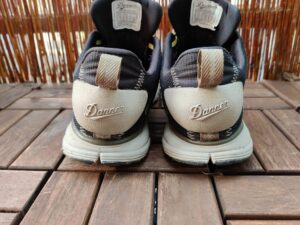
Deformed midsoles on Danner 2650 Trail shoes – the shoes are bent inwards and thus no longer suitable for wearing
The most common reasons for replacing footwear are loss of cushioning and support, torn uppers, worn out outsoles and parts ungluing. The first three things eventually happen with wear and tear to all footwear, no matter the quality. However, if your boots start to unglue it’s likely that they are low-quality or that an error has been made in production process. I have experienced in the past that the toe rand or the sole separated (unglued) on budget hiking boots.
To avoid any surprises on trails, I recommend regularly checking uppers, outsoles and insoles of the boots. You should also keep an eye on the cushioning and support. The best way to test cushioning is by walking on a flat firm surface. If the boots don’t provide cushioning, walking will feel uncomfortable.
If the uppers are torn there is not much you can do but to replace the boots. However, if the boots lose cushioning or the outsole is worn out you might be able to get them resoled, depending on the model. Most high-quality hiking footwear manufacturers such as Asolo, Lowa, and La Sportiva offer resoling services. That way, you can perhaps save some money, reduce the environmental footprint (pun intended) of your hiking footwear and avoid the potential discomfort of having to “break” a new pair of hiking boots in. Insoles are easier to replace. You can buy new insoles from manufacturer or a company that specializes in insoles like Tread Labs or Solestar.
How to increase the lifespan of you hiking footwear?
The most important thing when it comes to increasing lifespan of footwear is of course cleaning. You should clean your hiking footwear regularly because dirt dries out and degrades the materials. Leather boots are easy to clean. You simply scrub the dirt away with a brush. Textile footwear is often easier to clean if you make it first wet and then gently brush off the dirt.
Footwear with textile or suede leather uppers otherwise doesn’t need much maintenance. Full-grain leather boots should be regularly treated with a conditioner such as the Danner Boot Dressing. Applying conditioner prevents smooth leather boots from drying and cracking. In terms of storage you should make sure that your hiking footwear is stored in a dry space, out of sunlight and at a normal temperature. A humid basement is surely not a good place to store your hiking boots.
What warranty do hiking footwear companies offer?
Unless you receive a damaged pair of hiking boots, you’re pretty much at the mercy of the manufacturers when it comes to warranty claims. Manufacturers always state that normal wear and tear is not covered by the warranty, but they never explain what is considered normal wear and tear. Therefore, the manufacturer can reject your warranty claim the minute you have taken a short walk in their boots or shoes. I recommend sticking to reputable brands when you’re buying a pair of new hiking boots because they will probably take your warranty claim more seriously as they take pride in their brand.
Conclusion
How long hiking boots or shoes lasts, depends on the materials out of which they’re made, the terrain where you’re wearing them, storage and maintenance. If you are looking for a hiking boot with long lifespan, make sure that it has PU midsole, leather upper and comes from a high-quality brand. You should regularly clean your boots to prolong their lifespan and store them appropriately. If you have full-grain leather boots, you should also regularly apply conditioner which will prevent them from drying and cracking. In case that midsoles lose cushioning or outsole get’s worn out, do check out if it’s possible to resole your model. Note that normal wear and tear is never covered by the warranty.
I’d love to hear about your thoughts on the durability of hiking footwear. Write them in the comments section below.
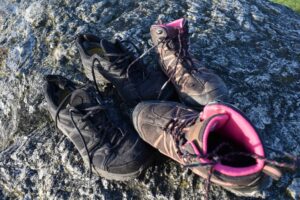
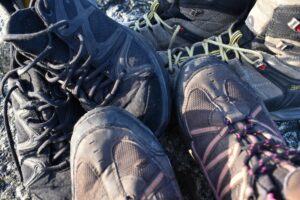





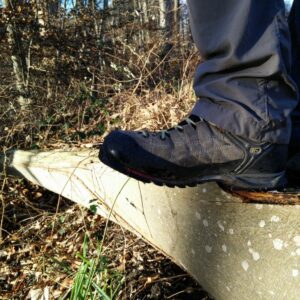

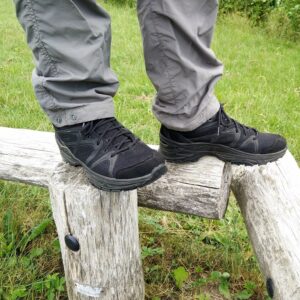

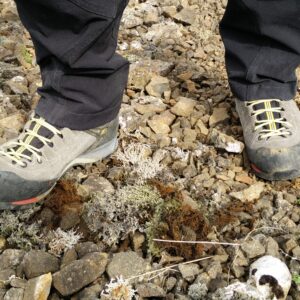
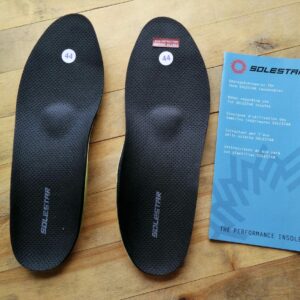
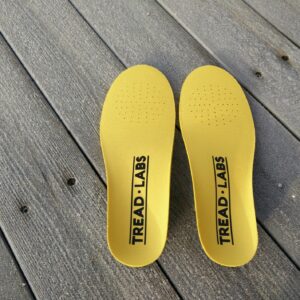












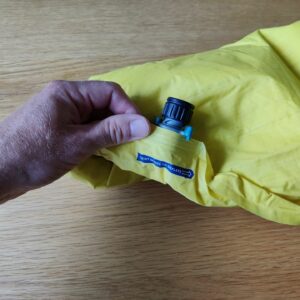

I usually try and get about 2,000 miles out of my walking boots. That’s a cheap pair of Karrimor Bodmins’..the last pair were only £21.99 from Amazon ( February 2023). The synthetic uppers always fall apart before the soles in my case. But I do take them to the limit…that means trying to wear them til there is a hole right through the centre of the sole and I can poke my finger through ( that’s if the uppers allow me to get that far). They are no longer waterproof long before that time, of course
But my feet are very hardy..I walk at least 60 miles a week. They never blister, even on a 30 mile first time trek on a brand new pair of Karrimors’. And finally, like Zola Budd the barefoot runner, I love to feel the stones through a worn out pair of boots. It’s like a foot massage and my feet are baby soft as a result.
Well, that’s an interesting point of view Stewart. You could also try to hike barefoot. It seems to be a thing these days. A bit about that here. Then you also save £20 on footwear 🙂
Regards,
Blaz